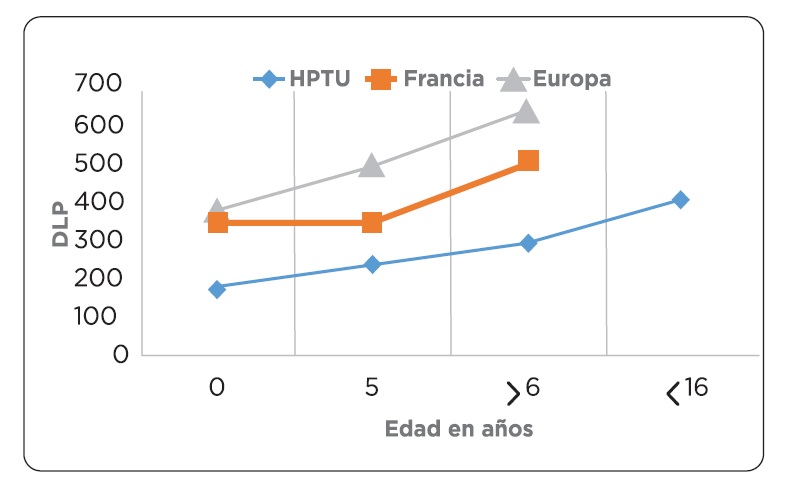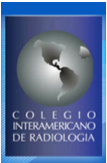Reference Levels of Radiation Dose for Imaging in Pediatrics
DOI:
https://doi.org/10.53903/01212095.43Keywords:
Multidetector computed tomography, Radiation protection, Radiation dosageAbstract
Introduction: Due to the characteristics and challenges of the pediatric population regarding radiation, the use of adequate doses of radiation is a duty of medical diagnostic centers. For this reason, the Dose Reference Levels (DRL) have been established in many countries to optimize and monitor the protocols of each institution. In Colombia there are no studies in this subject. Objective: To show the DRLs used in a university hospital of high complexity in the modalities of computed tomography (CT), radiography and fluoroscopy and to compare them with international standards. Methodology: Retrospective descriptive trial between 2018 and 2019. We analyzed dose length product (DLP) data for skull, chest, abdomen, and high-resolution chest CT (HRCT); and dose area product (DAP) for chest, abdomen, bone, and fluoroscopy radiography by age groups. Results: Data were collected for a total of 780 patients. 360 x-rays, 100 fluoroscopy and 320 tomography scans. Reference levels of radiation dose used in the hospital were found to be low compared to European guidelines of 2018 reference levels. DRLs are described for each study and age group. Conclusion: It was demonstrated that at the hospital where the study was conducted, reference levels of radiation in the pediatric population are low. This work can serve as a national reference.
Downloads
References
Hall EJ. Lessons we have learned from our children: cancer risks from diagnostic radio logy. Pediatr Radiol Roentgenol Nucl Med Ultrasound CT MRI. 2002;32(10):700-6.
Siciliano R. Radiological examinations in pediatric age. Ann Ig. 2017;29(2):134-40.
Leung RS. Radiation protection of the child from diagnostic imaging. Curr Pediatr Rev. 2015;11(4):235-42.
Mahesh M. Update on radiation safety and dose reduction in pediatric neuroradiology. Pediatr Radiol. 2015;45(Suppl 3):S370-4.
ICRP. Recommendations of the ICRP. ICRP Publication 26. Ann. ICRP. 2017; 1(3):1-53.
Slovis TL, Berdon WE. The ALARA concept in pediatric CT intelligent dose reduction. Pediatr Radiol. 2002;32:217-317.
Vañó E, Miller DL, Martin CJ, Rehani MM, Kang K, Rosenstein M, et al. ICRP Publica tion 135: Diagnostic Reference Levels in Medical Imaging. Ann ICRP. 2017;46(1):1-144.
Alzen G, Benz-Bohm G. Radiation protection in pediatric radiology. Dtsch Ärztebl Int. 2011;108(24):407-14.
Greenwood TJ, López-Costa RI, Rhoades PD, Ramírez-Giraldo JC, Starr M, Street M, et al. CT Dose Optimization in pediatric radiology: A multiyear effort to preserve the benefits of imaging while reducing the risks. Radiogr Rev Publ Radiol Soc N Am Inc. 2015;35(5):1539-54.
Harding K, Thomson WH. Radiological protection and safety in medicine - ICRP 73. Eur J Nucl Med. 1997;24(10):1207-9.
Célier D, Roch P, Etard C, Ducou Le Pointe H, Brisse HJ. Multicentre survey on patient dose in paediatric imaging and proposal for updated diagnostic reference levels for France. Part 1: computed tomography. Eur Radiol. 2020;30(2):1156-65.
The 2007 Recommendations of the International Commission on Radiological Protection. ICRP publication 103. Ann ICRP. 2007;37(2-4):1-332.
Strauss KJ, Racadio JM, Johnson N, Patel M, Nachabe RA. Estimates of diagnostic reference levels for pediatric peripheral and abdominal fluoroscopically guided proce dures. AJR Am J Roentgenol. 2015;204(6):W713-9.
Granata C, Sorantin E, Seuri R, Owens CM. European Society of Paediatric Radiology Computed Tomography and Dose Task Force: European guidelines on diagnostic reference levels for paediatric imaging. Pediatr Radiol. 2019;49(5):702-5.
Järvinen H, Seuri R, Kortesniemi M, Lajunen A, Hallinen E, Savikurki-Heikkilä P, et al. Indication-based national diagnostic reference levels for paediatric CT: a new approach with proposed values. Radiat Prot Dosimetry. 2015;165(1-4):86-90.
de Jesus FM, Magalhães LAG, Kodlulovich S. Paediatric CT exposure practice in the county of Rio de Janeiro: the need to establish diagnostic reference levels. Radiat Prot Dosimetry. 2016;171(3):389-97.
European Commission. Radiation Protection No 185 - European Guidelines on Diag nostic Reference Levels for Paediatric Imaging [internet]. 2018 [citado 26 de enero de 2020]. Disponible en: http://www.eurosafeimaging.org/wp/wp-content/uploads/2018/09/rp_185.pdf.
Resolución de 22 de enero de 2018, del Consejo de Seguridad Nuclear, por la que se publica el Acuerdo específico de colaboración con la Universidad de Málaga, para la realización de un estudio sobre aplicación de niveles de referencia de dosis (DRLs) en los procedimientos de radiodiagnóstico médico en pacientes, utilizados en los centros sanitarios españoles, así como su contribución a las dosis recibidas por la población (DOPOES II). BOE Bol Of Estado [internet]. 16 de marzo de 2018 [citado 26 de enero de 2020]. Disponible en: http://boe.vlex.es/vid/resolucion-22-enero-2018-705768553.
Célier D, Roch P, Etard C, Ducou Le Pointe H, Brisse HJ. Multicentre survey on patient dose in paediatric imaging and proposal for updated diagnostic reference levels for Fran ce. Part 2: plain radiography and diagnostic fluoroscopy. Eur Radiol. 2020;30(2):1182-90.
Ministerio de Salud y Protección Social de Colombia. Resolución 482 de 2018 [in ternet]. 2018. Disponible en: https://www.minsalud.gov.co/Normatividad_Nuevo/Resoluci%C3%B3n%20No.%20482%20de%202018.pdf
Jaramillo, W. Dosis de referencia pediátrica para tórax en Antioquia [internet]. 2012 [citado 11 de febrero de 2020]. Disponible en: https://prezi.com/42swipqtelek/simulador-antropomorfico-de-torax-para-nino-de-cinco-anos/?frame=a88657b102c8d7871822d048fe0150f64ffdbfdb
Deak PD, Smal Y, Kalender WA. Multisection CT protocols: Sex- and age-specific conversion factors used to determine effective dose from dose-length product. Radiology. 2010;257(1):158-66.
European guidelines on diagnostic reference levels for paediatric imaging - Publications Office of the EU [internet]. [citado 26 de enero de 2020]. Disponible en: https://op.europa.eu/en/publication-detail/-/publication/6e473ff5-bd4b-11e8-99ee-01aa75ed71a1/ language-en.
Frush DP. Justification and optimization of CT in children: how are we performing? Pediatr Radiol. 2011;41(Suppl 2):467-71.
Frush DP. CT dose and risk estimates in children. Pediatr Radiol. 2011;41(Suppl 2):483-7.
Salama DH, Vassileva J, Mahdaly G, Shawki M, Salama A, Gilley D, et al. Establishing national diagnostic reference levels (DRLs) for computed tomography in Egypt. Phys Medica PM Int J Devoted Appl Phys Med Biol Off J Ital Assoc Biomed Phys AIFB. 2017;39:16-24.
Brat H, Zanca F, Montandon S, Racine D, Rizk B, Meicher E, et al. Local clinical diag nostic reference levels for chest and abdomen CT examinations in adults as a function of body mass index and clinical indication: a prospective multicenter study. Eur Radiol. 2019;29(12):6794-804.
Klosterkemper Y, Appel E, Thomas C, Bethge OT, Aissa J, Kröpil P, et al. Tailoring CT dose to patient size: Implementation of the updated 2017 ACR size-specific diagnostic reference levels. Acad Radiol. 2018;25(12):1624-31.
Héliou R, Normandeau L, Beaudoin G. Towards dose reduction in CT: patient radiation dose assessment for CT examinations at university health center in Canada and compari son with national diagnostic reference levels. Radiat Prot Dosimetry. 2012;148(2):202-10.
Pantos I, Thalassinou S, Argentos S, Kelekis NL, Panayiotakis G, Efstathopoulos EP. Adult patient radiation doses from non-cardiac CT examinations: a review of published results. Br J Radiol. 2011;84(1000):293-303.
Arthurs OJ, van Rijn RR, Granata C, Porto L, Hirsch FW, Rosendahl K. European Society of Paediatric Radiology 2019 strategic research agenda: improving imaging for tomorrow’s children. Pediatr Radiol. 2019;49(8):983-9.

Downloads
Published
How to Cite
Issue
Section
License
Copyright (c) 2021 Revista Colombiana de Radiología

This work is licensed under a Creative Commons Attribution-NonCommercial-ShareAlike 4.0 International License.
La Revista Colombiana de Radiología es de acceso abierto y todos sus artículos se encuentran libre y completamente disponibles en línea para todo público sin costo alguno.
Los derechos patrimoniales de autor de los textos y de las imágenes del artículo como han sido transferidos pertenecen a la Asociación Colombiana de Radiología (ACR). Por tanto para su reproducción es necesario solicitar permisos y se debe hacer referencia al artículo de la Revista Colombiana de Radiología en las presentaciones o artículos nuevos donde se incluyan.







